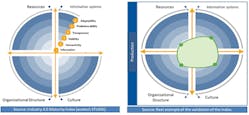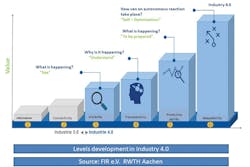According to a study carried out by the Boston Consulting Group, Industry 4.0, known as Industrie 4.0 in Germany, provides great added-value potential of 100 to 150 billion euros for the German economy within the upcoming five years alone. By international standards, in particular in comparison with the United States, Germany lags behind in terms of digitalization. In particular, small and medium-sized enterprises (SME) often shy away from taking consistent steps toward a comprehensive digitalization of their production. Many believe digitalization only works as a comprehensive package. Some simply lack the required know-how. This is where the Industrie 4.0 Maturity Index comes into play. It provides a digital roadmap with easy-to-implement single measures. Experts support enterprises in this maturity model. The analysis comprises the complete value chain — from development to production, logistics and service up to marketing and sales. The target is an agile company that optimally adjusts in real-time to changing requirements.
Figure 1. (Left) The experts determined the maturity stage of each of the four structural areas. Figure 2. (Right) Example of determination of the maturity stage in the functional area of production. Graphics courtesy of Industry 4.0 Maturity Index (acatech STUDIE)
Under the roof of Deutsche Akademie der Wissenschaft (acatech, German Academy of Science and Engineering) academic and industrial research institutes joined to form a broad consortium to develop the Industrie 4.0 Maturity Index. TÜV SÜD contributed its comprehensive IT security knowledge.
Clear concept, specific goals
The application of the Maturity Index comprises three phases. A team of external and internal experts starts with a review and determines the current situation in terms of digitalization. In the second phase, target conditions are defined. Together, gaps are identified and specific measures are initiated. After an assessment based on a cost-benefit matrix, the company is provided a digital roadmap. This measurements catalog shows detailed steps that need to be taken to achieve the set goals. The company is given investment safety since every single measure ensures measurable benefits.
Comprehensive transformation affects more than IT and production means. The corporate culture — willingness to learn and the attitude toward innovations, for example — plays an equally important role as the company’s organizational structure. This is why the Maturity Index differentiates the four structural areas: information systems, resources, organizational structure and corporate culture. They are based on six development stages. The first two stages, "Computerization" and "Connectivity," have often already been achieved. In the next stage, "Visibility," the company is able to generate a digital, always-current model of all processes, the so-called "digital shadow," by using real-time measurements. This visualizes the current
situation of the production facilities. With the ability to analyze and interpret the generated image, the stage "Transparency" is achieved. With these insights, future developments can be assessed. This corresponds to the fifth stage, "Forecasting Ability." At the highest development stage "Adaptability" systems are able to optimize processes autonomously and in real time.
Figure 3. Maturity Index: the six stages of maturity. Graphic courtesy of FIR e.V. at RWTH Aachen
Optimized maintenance through networking
At a manufacturer of connectors, device connection technology and network components, a good basis for the application of the Maturity Index was given due to the product portfolio and the resulting proximity to the topic digitalization. The first process phase could be completed within only a few days. The company used cutters for production at different sites in Germany. Their condition was being monitored by means of specific structure-borne sound sensors. In the framework of the transformation process, these sensors were networked. Real-time monitoring of all cutters across all sites was created from the single measurement data. The collected data contributes to being able to improve forecasting of wear and tear and to therefore optimize the maintenance intervals. Thus, machines can be continuously operated at optimum level. In total, the roadmap comprised more than 30 single measures. The quick wins were more efficiency, delivery reliability and production flexibility. Instead of several months, now only a few weeks are required to get from need for action to implementation.
Networked systems require cloud-based data structures. They are enablers for the digitalization of business processes, but also require an advanced level of IT security. For this reason, their usage is not yet a matter of course in SMEs. One way for secure filing and processing of data is the patented sealed-cloud technology. There, each single application server is secured and even the server operator cannot access the data. Thanks to technical and organizational measures, data are secured across the complete processing chain.
From vision to reality
The Industrie 4.0 Maturity Index provides companies a guideline to become agile and viable for the future. Thereby, tailormade measures are developed and the process of digital transformation remains transparent and controllable.
Dr. Bertolt Gärtner is president and CEO of TÜV SÜD ATISAE, Industrie 4.0 implementation expert. He may be reached at [email protected].





